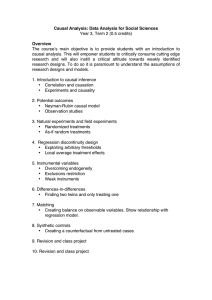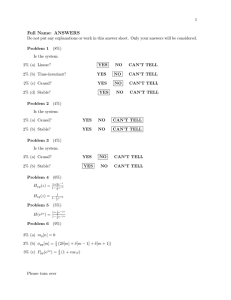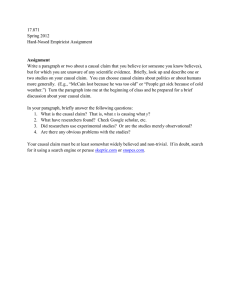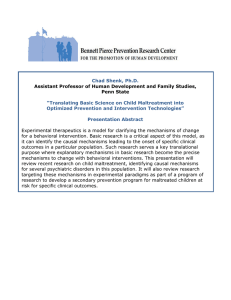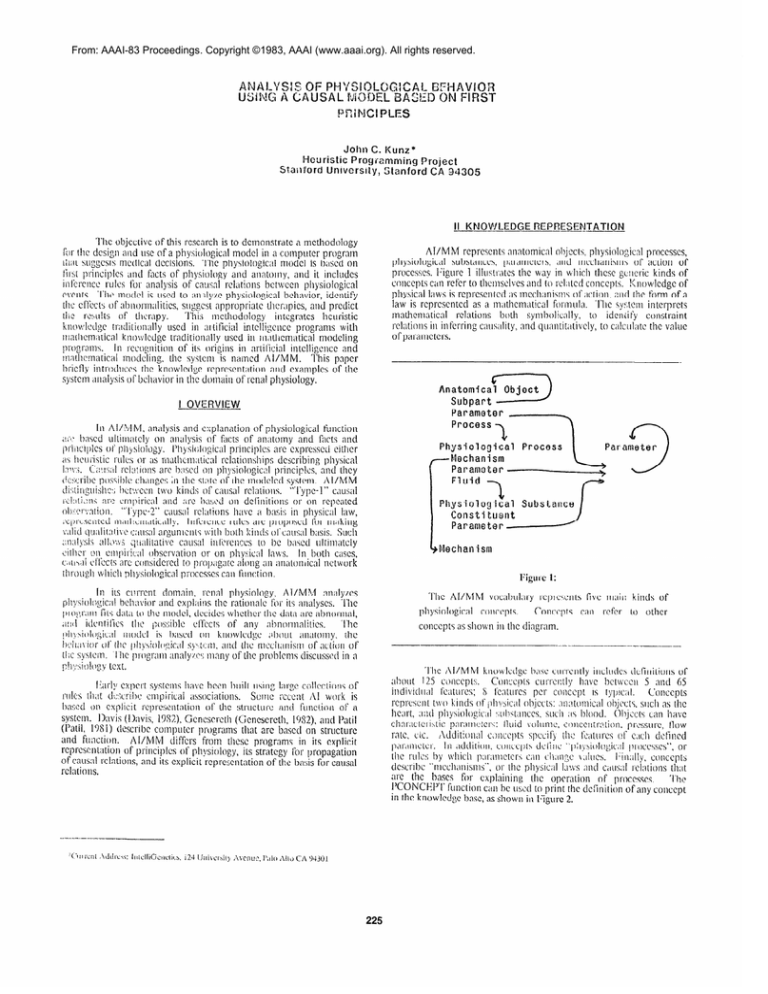
From: AAAI-83 Proceedings. Copyright ©1983, AAAI (www.aaai.org). All rights reserved.
John C. Kunz*
Heuristic
Proyr.amming
Project
Sta~lford
University,
Stanford
CA 94305
II KNOWLEDGE
l’hc objcctivc of this rcscnrch is to dcmonstratc a methodology
for the design and use of a physiological model in a computer program
tli,rt suggests medicA decisions. ‘l‘h~ phy~i~~l~~gic~\l
model is based 011
first principles and facts of physiology and anatomy, and it includes
inf’crcncc rules for analysis of ca~nl relations bctwccn physiological
cvcnts.
‘Ille model is used to :!n.?ly/c physiological bchnvior, identify
the cffcct!, of ~rbnonn~~litics, suggest appropriate thcr,lpics, and predict
This methodology
integrates
heuristic
tit
re4llts of thcr~py.
knowlctlge traditionally used in 31tificial intclligcncc programs with
mnrhcm~~ticnl knowlcclge traditionally used in In,~tlrcmaticnl modeling
programs.
In rcc:,ignition of it\ origins in artilicial intclligcncc and
rnathcmatical Inoclcling. the svstcm is named Al/MM.
This nnncr
hricfly introcluccs the Yknowlcdre rcprcscntation
and cxamslcs ;f ;he
system ininlysis of behavior in the do&n of renal physiology.
AI/MM rcprcscnts anatomical ohjccts, physiological processes,
physiological substanccc, parameters, and mechanism< of action of
proccnes. Figure 1 illu~tr~~tc’sthe way in hhirh thcsc gc:lcric kinds of
concepts can refer to thclnsclvcs and to rcl~~tctlconcepts. !<nowlcdgc of
physical laws is rcprcsentcd as mcchani\mc of~tion, ;~nrl the form of a
law is rcprcscntcd as a m~~thcm~~tical formul,~. ‘I’hc ~y~tenl interprets
mathematical
relations both syn~boIicalIy, to identify constraint
relations in inferring causality, and quantitatively, to calculate the value
of paramctcrs.
Anatomlcal
Sub,a,ty
Parameter
Process
I OVERVIEW
;\I/!,lM, analysis and explanation of physiological function
ultimately on analysis of facts of an,&)mv and facts and
pritlclI)Ics 01‘physioiogy.
l’h~~ic;lo$cal principlcs arc cxprcsscd cithcr
a\ hclil%tic rules or ;I:, m~thcm~~tical rclationahips describing physical
I,?!!“<. i.,r::~l rcl~!trons arc b:lscd on physiologic,!1 principlzs, and they
(t~::,(:tibe po:,4l)lc ch,mgcs in rhc ?t;?tc of ~hc modclccl system. /\l/hlM
iiistiliguishce, lwm~n rw kinds of caus,~l rclationc. “l’ypc-1” causal
~cl.lti,:n< arc empirical and arc bnscJ on definitions or on repcatcd
“‘l‘ypc-2”
c,~usal rcl:itionr have ii basis in physicA law,
m;~tl:~ri~ntic~ill!;. Infcrcncc rules arc t)roposed for making
thr-oii~li \vllich physiological
Object
,--
Physiological J
Procsss
Physiologi:al
Subseance
\
Par.a”9
::F:i:::i”d
proCcsScScan function.
IGgurc 1:
In iw cllrrcnt dom,iin, rcnnl pl~ysiology, Al/MM zm;~lylcs
phy4ol:;gic;tl bchGor and explains the rationale for it? an~lyscs. ‘I’hc
l)~o!‘,r,lnl fits data to the modci. dccidcs whcthcr the datn arc abno~ mal,
‘I‘hc
,I!K~ idcntilics
tllc ~:os:;iblc effects of any ahnor ninliticsI .
~~h~,~ic~l~~gical
moricl is hnscd on knowlctigc ‘thout an,ltomv. the
I):‘li,l\
ior 01‘tlX r~l?~~iol~~!:ic,~l
SL”tc.i?l. and the mcchanisrn of nc tion of’
The AI/hlhl
physiological
vocnbul,~ry rcp~c~nts
concepts.
Concepts
five nlair: kinds of
can
rcfcr
to other
concepts as shown in the diagram.
‘I‘hc Al/MM
II,lrly cxpcrt systems have been built us~n=,
- lar.~- collections of
Sornc ;‘cccnt Al work i$
rrllcs til,lL d;:‘;crihc: cnioirical ,issociations.
t)ilSCd
on explicit rc&scntntion
of‘ the strilcturc anti ftmclion of a
system. I)nvis (I)&,
19X2), Gcncscrcth (Gcncbercth, 1%2), alld l’atil
(Patil, 1981) describe computer programs that arc bnscd on structure
and fu;iction.
AI/MM differs from thcsc moeram? in its exnlicit
rcprcscnt:ltion of principles of ph~~siology, iLs‘stratcgp hr propag&on
of causal rclntions, and its explicit rcprcscntation of the basis for causal
relations.
REPRESENTATION
knowl4gc
bnsc currently illcludcs tlcfinitions of
Conxp~s currcI:tly hnvc bctwccn 5 and 6.5
indivitlr~,ll fe;ltures; S f‘c,mtrcs per concept is typical.
Collccpts
rcprescnt two kinds of i)h\/sicc\l ohjccts: anatomical objects, sllch ns the
heart, :IXI phy4ologic,rl 5utN,lnccs, such ii4 blood. Ot)j<cts fan have
chnl,lctel I\tic pnratnc::cri: Iluid Lollmic, ccmccntr:~tion. prcssurc, llow
rntc, L(C. I\tlditiorl,rl c,)nccpts spccirj 111,: t;‘,lturcc of C,IC~ dcfi ncd
paramctcr.
In &lition, con~cpt~ dcfin< ‘.I’l~!~,~ol(~gic~!I
I)Ioccsscs”, OI
the rules by which paianicts~ \ c~ii c‘h,inzc ~Jucs.
I~in,illy, conccpt~
dcscribc “niccli‘illisnis”, or the physic4 I~:vs ~iitl c,~uj,:l t clations that
are the bases for explaining
the operation
of proccsscs.
‘I‘hc
KONCW’L‘ function can bc used to print the definition of any concept
in the knowledge base, as shown in I:igure 2.
at?out
125 c,wccp1:5.
-PCONCEPT(Body)
.* Typed hy user.
; At1excerpt of Ihe AI/MM
; response is show below.
Concept name:
Body
AnatomicalObject
Concspt typo:
Fluid Volume:
BodyWaterVolume
Major Fluid:
Water
(Arteries BodyWaterSpace
Subparts:
Capillaries GI tleart Kidney Pituitary
RestofBody Voins)
Fluid Flows into and out of the body:
intake
WaterIntake
loss
GIFluidLoss
loss
loss
Bl oodLoss
InsonsibleLoss
loss
UrinoOutput
Paramotors:
total body water volumo
BodyWatorVolums:
Physiological
Anatomical
conn0ctions:
process:
\iater intake
output world
> intake GI
blrdoding
output Vsins
> intake world
Ronal psi-fusion
output At-tories > intalc Kidney
.
.
l
Excclpt of the dclinition
of Lhc concept of“klly”
psitilcd
by AI/MILI in response to a u:,cr query.
‘I‘hc knowlcdgc base inclu(lcs infcrcncc rules that NC bi)sCd 011
Using the c~sal
d definition of the causal rcLltion bctwccn stale.
rclntiou and the knowlcdgc of’anatoiriy and physiology, the program
m:lkcs infcrcn<cs about normal physiological behavior and the causes
and clTccts ol’abno~ maI physiological hchnvior.
Paramctcrs
may bc rclaLcd qunlitativcly
or quantitAvcly.
Crli~sal rcl::tions ;~rc used to infer lA~ysiologica1 behavior. For cx;~~:lplc,
llicsc relations iirc used to infer whcrc fluids can flow within an
;nlatomical nctkvork and to infer the cffcct of chang(:~ in l)l’CssurCs and
concentrations on Iluid flows and :‘o!umcs.
An 0: dnplc of a catrs,rl relation is shown IXIOW in Figure 3.
/\l/hlM IIXS the hII:!; kllowlctl~c
rcp~c~nt~iticin syAciri (Gc1k,~,~rclh,
IWO). ‘I‘llis cxa~~iplc of ;I rule ih i~~llii;tlly LILl~~slritcdlioin its hlI<S
syntax.
l’hc causal rule makes the causal relation bctwecn states
explicit, SUCI~ ;IS the relation bctwccn a flow and a fluid ciil>acity in this
cxamplc.
In addition, it explicitly describes the basis for the causal
relation.
1 define the basis of a causal
relation as its underlying
principle. ‘I‘hc basis of a causal relation is used in the explanation of its
USC. In AI/MM, the bases of causal relations include widely acccptcd
empirical ohscrvations and laws of physics, described rcspcctively as
‘I’ypc- 1 and ‘I’ypc-2 causal relations. “Infectious disease causes fever,
according to widely acccptcd clinical observation” is an example of a
cauul
r&ion
with a Type-1 basis in empirical observation
of
physiological behavior: The association bctwcen infectious disease and
fcvcr is widely known, yet the physiological
mechanism
for this
asr,ociatioii is not now widely understood.
“Increasing rcsistnncc to
flow in an artery causes
rcduccd blood flow through that artcry,
according to Poiscuillc’s law” is an cxamplc of a causal relation with a
Type-2 basis in physical law.
an anatomical
object
which has a
intaks namad $INTAKE, and
$CAPt?CITY is tha fluid volume of SAOBJECT, and
$ISIITAKE is abnormally increased, and
Change in fluid capacity of $AOBJECT equals
tho difference bstween its fluid intakes
and its fluid losses
THEN the increased .fluid intaka of $INTAXE may
cause increased fluid capacity of SOBJECT,
according to the law of conservation of mass
IF $AOBJECT is
fluid
Figure 3:
An cxamplc of a causal rule.
Variables y~cfixcd by “$”
arc uninstantiatcd.
The distinction bctwccn Type-1 and ‘l’ypc-2 b~scs has sc~c~al
ilnyortant uses.
t;irc;t, AI/MM cxpl,lins physiological behavior by
describing both the cxistcncc and the infcriccl basis or‘cau~il rcl&ions.
‘I’hc ‘oasis helps to elucidate the n,iturc of the infct led relations.
Scconti, ‘I’ypc-2 bases of causal relations are rclatcd to physiological
principles, and thus they may have brood npplic&ility
in diffcrc!lt
In
cor-li;‘T\t
don~ains and diffcrcnt contexts v. ithin a domAn.
l,nowlccl~c bases built soicly with ‘I‘ypc- I cnucal rclnliotls Mill ~p;;l;
only i;i Iimitcd spccilic domains and contexts. Al/MM ,icliicLcs soiiic
gclicr,ilily by applying IJWS 01‘physic\ ,111dli~nd,~~nc~~!~~l
lirir;ciplcs of
phjG0logy ill a uscfiil ;intl uniform way. ‘I bus, tlic ~,IIII~prlIIciplcs m;ly
IX 1iSCflil lilr analyzing 0tllCr d0KlaillS
to which thCW pr’iilCl~~lC:j ,lpply.
I:inally, the Type-1 / ‘l‘vpc-2 clis,tinction clearly idcntilics kn!)wIc&c
ba*;cd on well-undcrstoocl scientific principle from hcuri\iic ~IIOLV!CC~;;C.
‘l‘his di\iii!ction helps to identify promising arcns for liirrhl:r sciz:ltilic
rcscarch.
Type-1 bnses for c:~usal relations cali hnvc citlicr c;~~<rli!.\!i\
c 01
qiinnlit,ki~c forms, while I‘ypc-2 lmc:, fix cAllsa rcl<~llo!lc ‘\I\VLI)‘ll‘!VC
S
130th the inl,“ctious discnsc ai:d L!Ic rc:,istaiu
quantitLltivc forms.
cxamplcs quoted abo\c arc cxprcsscd in qualit&ivc form. l’hc basis for
the formcr rclatiou is cxprcsscd qualitatively. ‘I’hc basis for tl;c latter is
infcrrcd from d matl~cmaticnl rcprescntation of a physical law: ITlow =
Pressure / Iicsistance (Poiscuillc’s law, whicll is a version of Oliiti’s law
for fluids).
A single causal relation may bc used to dcscribc a pal titular
behavior. hIuch murc interesting :Im a single clausal relation, howcvcr,
is the infcrcncc of the description of a complex physiologicA behavior
based on a scqucncc of causal r&ions.
Cal~sal relations can be
propagntcd through an anatomical network, subject to the constraints
imposed by the physiological function of that network. A propugatcd
sequence of causal relations dctcrmincs a “mechanism of action”, Which
is a concept widely used in physiology and is often rcprcscntcd <ISa
diagram wit11 arrows connecting related physiologic;~l states. I dctinc a
mechanism of action in Al/MM as the scqucncc of causal relations by
which an initial physiological stntc (the GIIISC) /,r()l)ilgatcs through an
anatomical network to cause a resultant phyyio!oglcal state (the cffcct).
The mechanism of action provides a strong focus-of-nttcntion
heuristic for nnalyying a physiological model to clcacribc nnd predict
Problems arc nn~ily~cl in terms of the rcl,ltivcly small
behavior.
number of ‘l’ypc- 1 and ‘l‘ypc-2 relations that can affect pliy+ologicnl
behavior at any point in an an~ltomicnl network. In Adition, ,ittcntion
to mcchnnism5 of action helps to focus tlic process of acquiring new
knowlcdgc about ;I problem.
It is usc~‘ul to include knov.lcdgc of a
proccs$ in the kno:vicdgc b;~sc if the behavior of the l~roccss CAIIbe used
for inferring the behavior of the modcicd system. In ;Icldition, if a
process i\ important, its p,lralrlctcrs ~ntl its causal mechanisms .Irc Jso
important for inclusion in the knowlcdgc base.
111 EXAhIPLE.
-.--L---
ANALYSIS
GF STATIC
_--_-
FACTS
IV EXAMPLE:
c/!USAL
--____
ANALYSIS
Roth the user and the system Can rctricvc the quantitative value
of a paramctcr. Dcpcnding on Lhc cituation, \alucs Cdn bc looked up in
the d~abasc, Calculated from cxpcctcd default values, and in furl-cd. If
tllc J’aticnt \\cight, for cxatn~~l~~, 11~1sbeer, awrtccl
in tllc d;itabaac and
TIC LI\CI’typCS (VALUE
‘WE SGt IT), till’ \)jicIll
looks UP that L~I~ICLUld
plint\ it for the user. If the IIX~ types (?J:?LUE ’ (,DEFAULTVALUE
Uri 11a0ulput)
), t!lc systcnt dtcrnpts LOinfer ;I dclault value for the
ctirrcnt qLi.iliLatl\c St,itc 01‘ tllc pnlXlllCtCr.
Quantitative
piramctcr
V/nl:iC$ CiIIl ~ll\Ootkn IX CalClll,ttcd from qu:inLitatlvc rclntions.
‘J’hc AJ/ltJi$l knowlcdgc bnsc currently reJ~i’cscnts physioJogical
Lonccpts incladin~ the J)rin!-iplc that the whole equals the sum of Lhe
imL3,
Ohm’s law cxpicsscd
as Poisciiillc’s law nnd the St:n+ng
hypolhc~is,
anr! tl:c law ofcorww
2hn
of mas5 expressed siniJ,ly, as the
t:iCk prii;cipl2, ,Ind Lhc prillcii)lc; of dilution vo111mc and clcnrancc.
Figure 4 shoots a simJ)le cs,?nli~Ic in which OIIC of thcsc methods is
inl?rrcd by the system to 1~ J?oll-‘nlially ~~pJ~liCablc. I’his figllrc shows
thicc ways Lh,iL Al/Mhl h2il to c~ilcul,ilc lhc c,\liic of a J);\lLicular
paramctcr.
‘l‘hc first method is to m.ikc ;I :pccinli;ctl ph)Gological
mcasurcment, and the second is to use a rule-of-thumb cstimatc based
on dlc patient’s sex and weight. ‘i’hcse two methods arc explicitly
included in the knowlcdgc base. The third method is infcrrcd by the
system from the anatomical facts of the situation and the general
principle that the size of the whole equals the sum of the sizes of rhc
parts.
* Typed by the user.
l(VALUE '(VOLUME BodyWaterSpace))
; The respome a,ped b}j (he
; systm is showtl below.
Valuo
When the user simply asks for the value of a J)arnmctcr, as in
the example of l:igurc 5, the system first idcntifics alternative
calculation m&hods. ‘Ihen it uses a prccctlcncc heuristic to choose the
method in the current context that is likely to produce the most
accurate value of the specified pnramctcr, that is, dcpcnds least on
default values. Finally, having chosen a method, the system calculntcs,
reports and asserts the parameter value.
of (VOLUME BodyWaterSpace)
= BodyWaterVolume
= SEX-F TIMES !4EIGHT
= Fraction of total body woight assumed to
be water TIMES patient weight
= .B TIMES 70.0
[according to a Type-l relation
rapresontod as a regression equation]
= 42.00 [Liters]
Figure 5:
Computation
of a quantitative
systciri infers altcrnativc
method,
infcrrcd
The
the result
with n summary
of Lhc
intcrmcdiatc-lcvcl
slImmary; the heuristic used in preparing the toplcvcl bumnlary is to summ,lri/c effects ‘It the highest apJ,ropriatc Jcvcl
of nn,ttomical dctdil. hlorc del,iilcd nnallsis of cause and cffccts is
prcscnted nt a finer level of anatomical d&l.
To maasure (VOLUME BodyWaterSpace)
= BodyWaterVolums,
measure one of
VDISTRIBUTION
D20
Fraction of total body weight assumed 'to
be water TIMES patient weight
Sum of (volume of intra-cellular
fluid space,
volume of the extra-cellular
fluid space)
of the mclhods
and returns
vnluc of a paramctcr.
ways to calculate a value, chooses a
equaLion used in the Computation.
* Typed by rhe user.
~(MEASURE
9(VOLUME
BodyVatsrSpace))
; The response lypcd by the
9* synett~ is showtl below.
DcsCription
OF CHANGE
Consider Ihe CA< of a paticilt who I, obscr\ cd to drink 10 liters
of fluid in <Iddy (“NOI m‘il” is I .?I - 2.5 litcr\/day). ‘l’lic iiscr reports this
value to lhc progl,iirl ,lt.ti ,I\ks LJlz Jji~~~l~i~I~
to into, IIICI the Ggniticnnce
of tl~c obscr\atlon.
! igurc 6 bclou ~~O\VCthe input by tllc u>cr Ltnd th,:
tarp-lc\ cl su1n1n;ii y J~I\)\ idcd by AI/Xl Xl of the cff~ctc, of the spccificd
ol:s~~~~~,i~ioll.
Subscqi~i~;~L~tih5cctions itI turn SllliI\ the tlct,lilcd .innlysis
by the J>rogr<im of Lllc cuJ)cctcd physiologlcnl bcll:~viol of ihc motlclctl
system.
In addition to its cvplicitly rcprc\cntcd
facts, the A!/Mhl
knowlctlgc b<~sehas rules for infrrrin? t:,lCtSof physiology and anatomy.
‘I‘hrlS, the sy>tcm can infer val~ics !hat are not explicitly rcproscntcd
in
its knowledge bnsc. Withiit the tr:!dition of :ipplicd AI system,
Al/MM
is ;I rule-bzctl
system. f;or c.r:inlplc, Al/hlM ;1x5 IXICS tll<lt allow the
system to infer the identity of Al the ncstcd subparts of an an,ltomical
object.
determining
OF EFFECT
Validation of hypothcsixd
relations is an important issue in
Causal analysis. ‘I his issue is complicatctl in biological sy\tcnls when
each case is difl’crent and the analysis of A model can have only limited
,iCCuracy ill predicting
the bclU\, ior of 2 ~nodcIc~i14ystcin.
‘1 Ilc A 1/M kvl
;:ppr,).tch to the issue is to I-x <is carClill 25 J~o~;4blc in hyjlOll:cSi/itlg
c;il~snl relations and then t:) help the u\cr to v,~l:datc hg J)othcsi/ctl
rcl,ltions by identifying cffccts of the given cC~uscthat can hc tc+xl in
the modclccl system. Iti the :,ccond
cx;iml)lc [Figure 61. the syslctn
hypoLhcci/cs increasccl II!inc output 2s one raiilt of the inlti.4 ch;lngC io
Lhc sy:,tCITl.
An clcvalcd
urine
i)iiLJ~iltwc;uld Si!ppOl-t the i~ypl~~hesis
that
ths
caux
and cffcct arc rcl,~tcd in the qmilicd
way
in an
inditiidiial cdsc.
by the system for
Lhc vnluc of a particul,ir paramctcr.
227
‘I‘hc rcnsoning shown in this example is typical of /?,I/MM.
'I'lic
sy\tcn~I~C~ISOI~S li~~~w:i~xl fl.om ohscructl c‘~usc to I?) polhc5i/(‘d
cl‘l~ct. III the prcscticc ol’cvitl~~c for 2 I~ypollic~iA cl‘l~cl, 1hc \ystcm
xsu1iIcs
Ill,11 lllc cKccL is prownt
!iN Ihc plticnt.
‘l‘hc \,)i\ICll1 then
sc;ir(.hcs li)r furLher cffccts of the newly II) pothcsi/4
c,!uTc.
I’ropnj;;itlon of cffccts COlltitllics
until no flit thcr cl‘l‘ccts arc forind
or
until ;I ncg:rtivc Ii&back loop is rccogni/cd.
I’hc v,ili:lity of Ll~c
inl‘crrctl scqucnccs of cvcnts cm bc tc5lcd in the IllOdCictl syjtcm,
namely, rlic palicnt. Al/Iv1 M c;~n propose tcL,.t’to
; confirm thil p~cscncc
01’hypotlicsiycd st;itcs. li)r cxamplc, it coi11d ~!!:gcst that tirinc output
SllO~llCl IX lIlL‘iISlII’Cd.
AI/MM also report5 rior~nal tlici ;ipy goals li)r
CXil nbnorm:~l st:\tC in a caXXtle of‘CffcctS; in the CxAiIlplC,
il0ilC WAS
found.
; TJpn’ by hi user.
-(INTERPRETVALUE
'NatorIntake
10)
Water Intake of 10 Liters/day
is in ,the
range 5 Liters/day
< lilater
intake <= 20
Liters/day,
which
is moderately
elevated.
tYormally,
increassd
water
intake
causes
Increased
body
increased body water volume.
water volume causes decreasad
water intake.
incraasod
body sater
volume
In addition,
causo3
increasad
urino
output.
Incransad
water
urine
output
CaUSQS
reduced
body
Increased
urine
output
normally
volume.
will continue until body water volume returns
to ncrmal.
:t4odsrately irlcreassd water intake
doss not normally require therapy.
function is the overflow dinin in a bathroom sink. When the regular
drain is closed. the overflow drLrin will keep the sink from overflowing
if thcrc is a structural connection bctwccll the obcrflow-dr,Iin entry and
the regular drain pipe and if the function of that ovcrilow pipe is
normal -_ for cxamplc, free of potatoes.
Normally,
increased
body
the effect
of
mass.
increassd I.vater intake causes
according
to
water volume,
the law of conservation
of
Incraasad
renal
reduced
to
according
relation.
water
body
water
tubule
ampirical
an
watsr
renal
tubule
Decreased
renal
tubule
reduced
causes
permeability
to
the
affect
of
reabsorption,
according
Poiseuille's
Law.
rscbsorption
tubule
renal
Decreased
urine output,
according
to
caus33 increased
the effect
of the law of consorlJation of
mass.
Increased
urine
output
causes
reduced
the effect
body water
volume, according
to
mass.
consarvation
of
1 aw
of
of
the
will continue
until
Increasad
urins output
body water
voluma roturns to normal.
Figure7:
Intermcdiatc-lcvcl
A.
SeQaence
of Causal Events
Figure 7 summarizes the cascade of causal inferences made by
AI/MM as it infers that incrcascd water intake can cause incrcnsed
urine output (named IJrincOutput
in the knowlcdgc base). ?‘his
summary was prcp:;rcd by the system by describing cnch elcmcnt in the
ini’crrcd cnscndc of causal relations. I :ach causal relation in this cascade
is infcrrcd bccausc thcrc is a lawful basis for the relation and bccausc
thcrc is an anatomical network througii which physiological functions
can propagate and allow the cause to product lhc cffcct.
Th,
the
individual relations in &his cnsc::dc arc intcrmcdiatc
in detail lcvcl
between the top level, shown in Figure 6, and the most dctailcd analysis
pcrf~rmed by the ,;yntcm. lhc first r&lion in the cascndc shown in
liigurc 7, [or e,~;tnli)le, describc5 the fluid flow from the outside to the
g;i~trc,il~tc~tin~ll Cr‘I?‘t(Gl), through the Cl, from th,o GI to tile veins,
m.i
so on. ‘l’he second relation 111Ihe cascade describes the cffcct of
Antidiurctic hormone.
‘lhc AI/h,! M CnUSill rules will infer that d physiological event,
such as an i:lcrcasc in water int:lkc. is ;I possible LYISCof a second cvcnt,
such as incrcascd urine outptit. if ;I hypothcsiA
c,I:isnl relation has a
lcgitimalc iNsis anti is pL\usiblc. ‘I lit b:rsis of a cu.rs~il rclnlion is cithcr
a ‘l’ypc-l basis in cnqirical obs:‘r\:;tion or a l‘ypc-2 basis in physical
law. A causal rcl:ttion is plausibic il‘it is not known to bc impossible in
a context and if thcrc is an dl\i\t<>mical link by which normal
physiological
liinction cnn cause didii~c
in the tit’9 pnrnmctcr to
change
in the second
par,lmctcr.
A
]m~p~lg<ltc
illld w11sc
~!~,I:pl;ysiologic~iI c :~nmplc of a~ anatomical
link that supports a
summary
of the scqucncc
high water intake. This summary wets prepared
Each
of these
anatomical
Figure6: Initial top-level summary by AI/MM of the expected
cfFccts of a given mcasurcmcnt.
volume
causes
parmeability,
causal
Type-l
conclusions
is dcscribcd
detail that is intern;edi;itc
of effects of
by AI/MM.
at a lcvcl
of
between the top-level
summary and the detailed casc,ldc of effects.
‘d CoNcLUSION
AI/MM includes modest but nontrivial r;tructur:,l complexity
in its rcprcscntation of the dom,jin anatomy. It rcprcscnts bchLILior that
is partially understood in terms of ln\cs of physics al:rl hz;ic dctinitions.
Use of AJ/MM shows that it is possible to analy,~c the bchnvior of a
physiological system based on kno,vleiigc of anatotny. 1?hysiological
In this application,
proccssc~. and Rrst principles of phyciology.
intcgr:ltcti ~42 of symbolic ,Ind qu;rntit,ltivc analysis is rn~~c powerful
than cithcr one alvnc. Symbolic knowlcdgc is used to infer both the
qu:ilit:ttivc rcl;ltions and tlic mAcm,lticcil
constr2inls that rcL)tc the
parameters of the modeled system. Thus, symbolic analysis is useful for
structuring problems to bc solved in particul,lr cases. Quantitative
analysis is nccdcd to actually analyze the qunntitativc behavior of a
modclcd
system.
Quantitative
analysis can resolve qualitative
ambiguities, and it can provide quantitative estimates of values for
parameters that arc not or cannot be measured.
The model contains knowledge of anatomy, function, and
mechanism. It may bc possible to WC such models to analyze behavior
of a broad class of systems similar to that of this project.
‘1’11~AI
techniques allow an integrated representation
of all the knowledge
included in the model, including its definitions, anatomy, behavior, and
mechanisms.
Knowledge may bc represented and used in a qualitative
or quantitative form, as appropriate.
The same inference procedure is
used to infer both normal and abnormal behavior.
Because the basic
inference method is to propagate
effects through an anatomical
network, the inference procedure wit1 exploit the available information
that is relevant, and it ignores irrclcvant infonnation.

